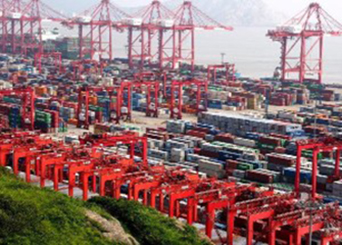
Kunming and the New Burma Road: Building Up not Bombing Down
By F. William Engdahl
11 June 2017
While the cowardly Trump Administration and its Generals pathetically try to parade their manliness to a puzzled world by lobbing giga-bombs and cruise missiles around the world from Syria to Yemen to Somalia to Afghaistan, China and her Eurasian neighbors, notably the Russian Federation, and the countries of the Eurasian Economic Union, are building up the peaceful economic alternative. It’s centered around Xi Jinping’s visionary One Belt, One Road (OBOR) or New Economic Silk Road infrastructure project that is quietly transforming the economic development energy of the world away from the depression, bankruptcy, wars and debt crises of the EU and United States.
It is instructive to merely note the most recent developments of this multi-trillion dollar infrastructure plan that far exceeds anything being discussed in the United States or Europe. The OBOR is very serious, very real and very feared by the United States’ warmakers.
China-Myanmar-Persian Gulf
In early April this year, a 770 kilometer oil pipeline began to flow oil as Myanmar opened a new deep water port at Kyaukphyu on the Indian Ocean. The project, officially begun in 2007 well before the strategic concept of a New Economic Silk Road was mature, is a vital part of China’s OBOR strategy. It consists of a US$2.45 billion port and pipeline project that will carry crude oil from the Middle East to China’s Kunming, the city near the border to Laos that is rapidly becoming a transportation cross roads in the Eurasian OBOR. The oil pipeline is a joint venture between China National Petroleum Corp. (CNOC) and Myanmar Oil and Gas Enterprise (MOGE), both state companies. The landing port in Myanmar’s Bay of Bengal has twelve storage tanks with capacity to store 520,000 barrels oil. When the oil pipeline is at full capacity, according to CNOC, the pipeline will be able to transport an estimated 400,000 barrels of oil per day from oil producers in the Middle East and Africa. Refineries to receive the oil inside China are completing construction.
The new deep water Indian Ocean port of Burma links the interior of China to oil flows from the Middle East, averting the risky Malacca Straits.
In geopolitical terms, the Myanmar-China port and pipeline will allow China to import oil from Persian Gulf producers as well as African, without having to take a far longer and militarily more risky route through the narrow Malacca Straits. The Malacca Straits, a narrow water passage is today the shipping route connecting the Indian Ocean and the Pacific Ocean in the region of the South China Sea.
The Myanmar link will greatly shorten transport time and costs. The next phase of the new infrastructure corridor through Myanmar, the former Burma, will involve construction of a port for dry containerized and bulk cargoes, and a high-speed railway linking Kyaukphyu to Kunming, in Yunnan Province in central China. A modern industrial city of some 7 million people which I had the honor to visit two years ago, Kunming is called by the Chinese the “City of Eternal Spring.”
The opening of the Kunming to the Indian Ocean pipeline is being called by oil analysts “one of the biggest developments of the decade for global crude flows.” It will allow China to receive oil from key producing centers like the Middle East and Africa directly off the Indian Ocean — eliminating days of sailing through the Strait of Malacca route between Indonesia and Malaysia.
Kunming, under the OBOR blueprint, will now become the hub and terminus for what will be called the “Pan Asia High Speed Network” with high speed trains to connect China, Cambodia, Laos, Myanmar, Thailand, Malaysia and Singapore.
The vast multi-route Pan-Asia Rail Network when finished will efficiently integrate the economies of Southeast Asia with China for the first time creating huge new markets
When the Pan-Asian link of OBOR is finished within the next five years–and Chinese construction projects are generally on time and on target–among other aspects it will enable rail travel between Kunming and the city state of Singapore–as the crow flies some 2,600 kilometers–in just 10 hours.
The Pan-Asia High-Speed Network section of OBOR consists of three separate high-speed lines of each between 4,500-5,500 kilometers (2,800-3,400 miles) that will run through Myanmar, Laos, Thailand, Vietnam and Malaysia, railway lines that will link China for the first time integrally with the economics of mainland Southeast Asia, a market combined of more than 250 million people, carrying both passengers and freight.
The Myanmar-Kunming-Pan-Asia High-Speed Network development is but a small part of the ongoing transformation of the economic and political space of the world’s largest landmass, Eurasia. I have termed this the building up of the Eurasian Century. Today more than 65 countries have formally agreed to participate in the One Belt, One Road development including in addition to China, the Russian Federation, Belarus, Kazakhstan, Mongolia, the Central Asian republics of the former Soviet Union, Afghanistan, Azerbaijan, Iran, UAE, Qatar, Saudi Arabia, Turkey, Israel, Palestine, Egypt, Bosnia-Herzegovina, Croatia, Serbia, Bulgaria, Hungary, Czech Republic, Macedonia, Romania, Poland. A look at the world map will underline the scope of this remarkable vision that was first formally presented by China President Xi Jinping in 2013 in Kazakhstan.
Another Concept of Globalization
Today, China and Russia and the Eurasian nations centered around the Shanghai Cooperation Organization are in the pursuit of building up economies, of building bridges, land and sea, of using diplomacy and respect for national sovereignty, non-intervention into domestic national affairs to foster peace and development.
When he was in Florida meeting Donald Trump, Xi Jinping also invited the United States President to join the vast OBOR infrastructure. This, despite the fact that Trump and Co. had deliberately timed the US illegal bombing of the Syrian airbase to coincide with dessert toasts in a state dinner with a not-informed Xi, a deliberate attempt to make China’s president “lose face.” It seems by his subsequent actions that the Chinese President is well above Trump’s infantile games.
On May 14, Beijing hosts a major international conference to discuss the One Belt, One Road. As of this writing 28 heads of state or government will attend. The United States, Germany, UK and France are conspicuously absent, as is the European Union as an institution. EU member states including Hungary, Italy, the Czech Republic, Poland, Serbia, Spain will be there. This speaks volumes about the deepening fault lines within the failing European Union, where the unelected de facto Politburo called the EU Commission has done much to ignore the potential economic benefit of embracing the OBOR, an open-ended project which has as major aim to integrate all of Eurasia including the European part of Eurasia to the Atlantic.
Notable is that China’s version of OBOR is an entirely different concept of economic globalization, one based on diplomatic negotiations between sovereign nation states no matter how large or small. Washington’s globalization is about the destruction of nation states and of sovereignty.
While Washington and NATO are busy warring around the world all over the place, trying desperately to put the broken pieces of their global hegemony back together at the barrel of a gun or impact of a giga-bomb, blowing up bridges, China, Russia and others are about building bridges. It is a contrast notable.
F. William Engdahl is strategic risk consultant and lecturer, he holds a degree in politics from Princeton University and is a best-selling author on oil and geopolitics, exclusively for the online magazine “New Eastern Outlook”
